Subscribe our newsletter
Please Subscribe our news letter and get update.
[newsletter]

Overview:
The term “porphyria” encompasses a collection of eight disorders that impact both the skin and nervous system. Most of these conditions are hereditary, passed down through family lines. Porphyrins (natural chemical) play a crucial role in the production of heme, a component of hemoglobin, the protein responsible for transporting oxygen to the body’s organs and tissues. To transform porphyrins into heme, the body relies on eight enzymes. When there is an insufficient amount of any of these enzymes, porphyrins build up, leading to elevated levels in the body. Such high levels of porphyrins can cause significant issues, particularly affecting the nervous system and skin as observed in Acute intermittent porphyria (AIP). It is caused by low levels of porphobilinogen deaminase. The main symptoms of AIP include insomnia, anorexia, changes in urine color, myalgia, and urinary retention. The condition can lead to liver tumors (hepatocellular carcinoma) and kidney failure. Gastrointestinal, urinary tract, psychological, and neurological issues are also common symptoms. Medications such as Panhematin, Normosang, Givlaari, chlorpromazine, and hemin can be used for its treatment. AIP is considered a rare disease. The exact prevalence is not well-known, as many cases may go undiagnosed due to its variable and nonspecific symptoms. It is estimated that AIP affects fewer than 5 in 100,000 individuals in the general population. The prevalence may vary among different populations and regions
The treatment goal for acute attacks of Acute Intermittent Porphyria (AIP) is to decrease heme synthesis and reduce porphyrin precursors. High-dose intravenous 5% glucose in 0.9% sodium chloride solution is recommended for mild attacks. Avoid intravenous glucose in water (D5W, D10W) to prevent aggravating hyponatremia. Patients experiencing severe attacks, particularly those with severe neurological symptoms, should be administered hematin at a dosage of 4 mg/kg per day for a duration of 4 days. Givosiran (Givlaari) has received approval from the US Food and Drug Administration (FDA) for use in adults with acute hepatic porphyrias characterized by attacks induced by the enzyme 5-aminolevulinic acid synthase 1 (ALAS1). Givosiran is a small-interfering RNA that functions through RNA interference, causing degradation of aminolevulinate synthase 1 (ALAS1) messenger RNA (mRNA) in hepatocytes. This mechanism helps reduce elevated levels of liver ALAS1 mRNA. The treatment involves monthly subcutaneous injections. Symptomatic treatment involves the utilization of beta-blockers to manage tachycardia and prevent arrhythmia. For hypertensive crisis, beta-blockers, clonidine, or other recommended antihypertensives can be employed. To control nausea and vomiting, olanzapine, lorazepam, or prochlorperazine can be utilized. Seizures are treated with Gebapentin; as most anti-seizure medicine can be contraindicated.
SCOPE:
To effectively assess the class competition over the short to medium-long term, it is essential to possess a comprehensive grasp of the development pipeline. This detailed understanding plays a crucial role in strategically positioning a product within the market.
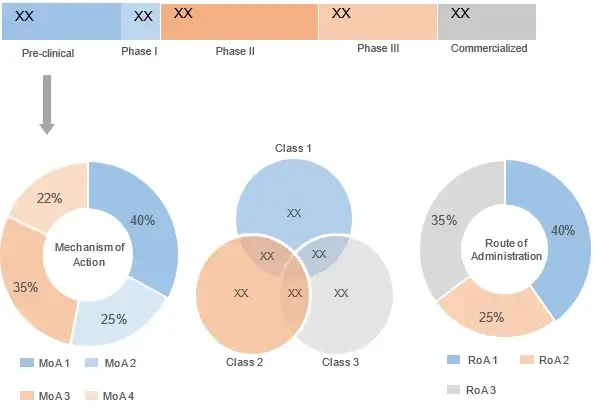
The stakeholders involved in the development of treatment solutions for Acute Intermittent Porphyria have been compiled, encompassing pertinent details such as financials, product portfolio, and recent advancement
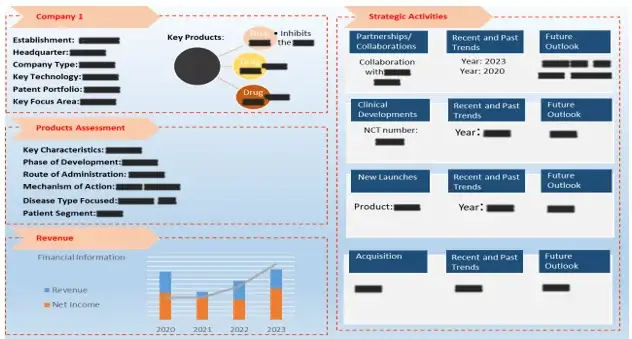
Through patent analysis, one can gain invaluable insights into the innovative developments and emerging technologies related to Acute Intermittent Porphyria. This process facilitates a deeper understanding of novel treatment approaches and their potential in the field.
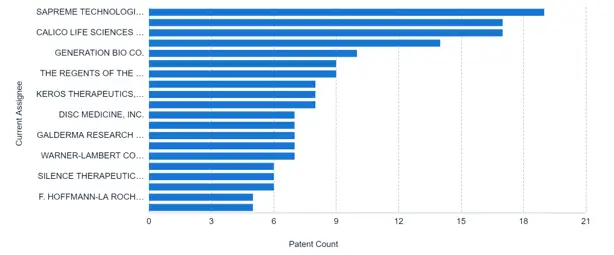
Over the past five years, several drugs/therapies evaluated in clinical trials across various regions have progressed to advanced stages of development or have reached maturity.
Distribution by Key Geographical Areas

Distribution of Clinical Trials by Status
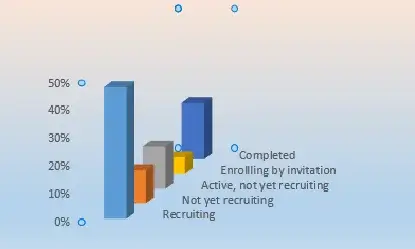
Distribution of Clinical Trials by Phase of Development
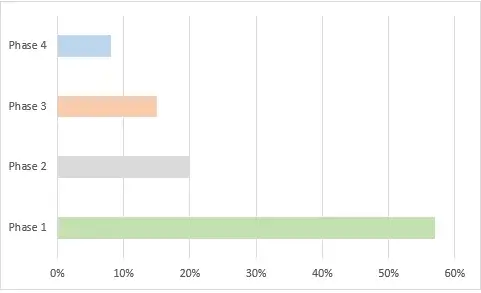
The market is poised for substantial growth over the next decade due to the approval of multiple drug candidates and promising clinical outcomes. As a result, it is now distributed across various segments to accommodate the increasing demand.

The presence of numerous companies operating in the field of Acute Intermittent Porphyria can lead to potential competitors vying to gain a dominant position in the market.
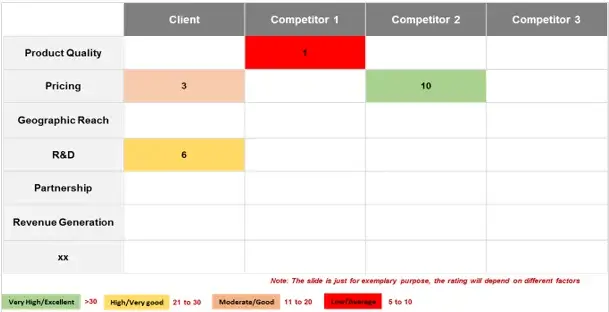
Research Methodology:
In order to give the most precise estimations and forecasts, Wissen Research uses an extensive and iterative research approach that is focused on reducing deviation. The company blends top-down and bottom-up methodologies for market segmentation and quantitative estimation. In addition, data triangulation, which examines the market from three separate angles, is a recurrent topic present in all of our research studies. Important components of the approach used for all of our studies include the following.:
On a wide scale, unprocessed market data is collected. Continuous data filtering makes sure that only verified and authenticated sources are taken into account. Additionally, data is extracted from a wide range of reports in our repository and from a number of reputable premium databases. We gather information from raw material suppliers, distributors, and purchasers to help with this since understanding the entire value chain is crucial for a thorough understanding of the market.
Surveys, technical symposia, and trade magazines are used to gather information on technical concerns and trends. Technical information focusing on white space and freedom of movement is also obtained from an intellectual property standpoint. Additionally, information on the industry’s drivers, constraints, and pricing patterns is obtained. As a result, a variety of original data are included in the material that is then cross-validated and certified with published sources.
We use simulation models to generate our market projections and estimates. Every study receives a special model that is tailored to it. Data for market dynamics, the technology environment, application development, and pricing patterns are gathered and supplied into the model all at once for analysis. The relative relevance of these factors is investigated, and their impact on the forecast period is assessed, using correlation, regression, and time series analysis. The process of market forecasting combines technological analysis with economic strategies, practical business acumen, and subject expertise.
Econometric models are frequently used for short-term forecasting, but technology market models are typically employed for long-term forecasting. These are based on a confluence of the business environment, regulatory environment, economic projection, and technical landscape. In order to develop global estimates, it is preferable to estimate markets from the bottom up by integrating data from key regional markets. This is required to ensure accuracy and a complete comprehension of the subject. Among the variables taken into account for forecasting are:
scenario for raw materials and supply versus pricing patterns
Regulations and anticipated developments
We give these criteria weights and use weighted average analysis to assess their market influence in order to calculate the anticipated market growth rate
Primary research | Secondary research |
· Manufacturers · Technology distributors and wholesalers · End-user surveys · Consumer surveys | · Company reports and publications · Government publications · Independent investigations · Economic and demographic data · Online searches · Literature studies · Research reviews · Case studies · Reference customers |
1. Executive Summary
1.1 Key Findings
1.2 Market Overview
1.3 Market Insights
2. Introduction
2.1 Research Scope
2.2 Methodology
2.3 Report Objectives
2.4 Data Sources
3. Disease Overview
3.1 Introduction to Acute Intermittent Porphyria (AIP)
3.2 Causes and Risk Factors
3.3 Symptoms and Clinical Presentation
3.4 Diagnosis and Diagnostic Techniques
4. Market Landscape
4.1 Market Size and Forecast by Type of AIP, 2023-2033 (USD Million)
4.1.1 Sporadic AIP (Type 1)
4.1.2 Familial AIP (Type 2)
4.2 Market Size and Forecast by Age Group, 2023-2033 (USD Million)
4.2.1 Adults
4.2.2 Pediatric Population
4.3 Market Size and Forecast by Region, 2023-2033 (USD Million)
4.3.1 North America
4.3.2 Europe
4.3.3 Asia Pacific
4.3.4 Latin America
4.3.5 Middle East & Africa
4.3.6 Market Trends and Outlook
5. Patent Analysis
5.1 Top Assignee
5.2 Geography focus of top Assignees
5.3 Medications and Drug Classes
5.4 Legal Status
5.5 Geography
5.6 Assignee Segmentation
5.7 Network analysis of the top collaborating entities in AIP treatments patent applications
5.8 Technology Evolution
5.9 Key Patents
5.10 Application trend
5.11 Application and Issued Trend
5.12 Key technology
6. Product Analysis
6.1 Current Treatment Options
6.1.1 Approved drugs
6.1.2 Pipeline drugs
6.2 Emerging Therapies and Research Developments (by product analysis and scientific analysis)
6.3 Medications and Drug Classes
6.4 Therapeutic activity of drugs
7. Clinical trial Analysis
7.1 Chapter Overview
7.2 Analysis by Trial Registration Year
7.3 Analysis by Phase of Development
7.4 Analysis by Number of Patients Enrolled
7.5 Analysis by Status of Trial
7.6 Analysis by Study Design
7.7 Analysis by Type of Product
7.8 Analysis by Geography
7.9 Analysis by Key Sponsors / Collaborators
8. Market Dynamics
8.1 Market Drivers
8.2 Market Restraints
8.3 Market Opportunities
8.4 Challenges and Future Prospects
9. Competitive Landscape
9.1 Market Share Analysis
9.2 Company Profiles
9.2.1 Recordati Rare Diseases
9.2.2 CLINUVEL Pharmaceuticals
9.2.3 Siemens
9.2.4 Alnylam Pharmaceuticals
9.2.5 Sysmex Corporation
9.3 Competitive Strategies and Developments
10. Regulatory and Reimbursement Landscape
10.1 Regulatory Approvals
10.2 Reimbursement Policies
11. Market Outlook and Future Trends
12. Conclusion
13. Appendix
13.1 List of Abbreviations
13.2 Research Methodology
13.3 Data Sources
13.4 Disclaimer
S.no | Key Highlights of Report | |
1. | Patent Analysis | · Top Assignee · Geography focus of top Assignees · Assignee Segmentation · Technology Evolution · Key Patents · Application and Issued Trend · Key technology |
2. | Market analysis | · Current Treatment Options (Approved and Pipeline drugs) · Emerging Therapies and Research Developments (by product analysis and scientific analysis) · Therapeutic activity of drugs |
3. | Clinical Trials | · Analysis of clinical trial through graphical representation · Coverage of treatments from pre-clinical phases till commercialization (also including terminated and completed studies) |
4. | Forecast | · Detailed comprehension of the historic, current and forecasted trend of market by analysis of impact of these treatments on the market |
5. | Key Players | · Detailed profiles of the key players that are engaged in the development of approved drugs |
6. | Strategic activities of companies | · Collaboration/Mergers/Agreements/Partnerships/Acquisitions taken place by analyzed companies |
7. | Opportunity Analysis | · Technology evolution based on problem solution · Potential licensees · Geography of suppliers · Treatment trends |
8. | KOLs | · A detailed analysis and identification of the key opinion leaders (KOLs), shortlisted based on their contributions |
9. | SWOT | · SWOT analysis for treatments · Market Access |
LIST OF FIGURES
Figure number | Description |
Figure 1 | Terminology of Acute Intermittent Porphyria Over The Years |
Figure 2 | Acute Intermittent Porphyria Treatment– History and Present |
Figure 3 | Projection of Acute Intermittent Porphyria till 2033 in different geographies |
Figure 4 | Technology Categorization Of Drug Delivery Methods For Acute Intermittent Porphyria |
Figure 5 | Recent Technology Trends in Acute Intermittent Porphyria |
Figure 6 | Technology Evolution in Drug Delivery Market of Acute Intermittent Porphyria |
Figure 7 | Geographical Distribution of Patents of Top Assignees |
Figure 8 | Assignee Segmentation (Companies) |
Figure 9 | Assignee Segmentation (Educational Establishment) |
Figure 10 | Patent Based Key Insights Of xx |
Figure 11 | Patent Based Key insights of xx |
Figure 12 | Patent Based Key insights of xx |
Figure 13 | Geographic Distribution of the Universities/Research Organizations Filling Patents On Various Drug Delivery Approaches |
Figure 14 | Key Summary Regarding the Patent Filing On Acute Intermittent Porphyria |
Figure 15 | Product Pipeline of Different Approaches with Companies Name |
Figure 16 | Portfolio for Approved Product |
Figure 17 | Clinical Trials Conducted till Date by Different Companies and Universities |
Figure 18 | Clinical Trials based Key Insights |
Figure 19 | Key Growth Drivers for Acute Intermittent Porphyria |
Figure 20 | Restraints for Acute Intermittent Porphyria |
Figure 21 | xx Portfolio (Top Player) |
Figure 22 | xx Portfolio (Top Player) |
Figure 23 | xx Portfolio (Top Player) |
Figure 24 | xx Portfolio (Top Player) |
Figure 25 | xx Portfolio (Top Player) |
Figure 26 | xx Portfolio (Start-up) |
Figure 27 | xx Portfolio (Start-up) |
Figure 28 | xx Portfolio (Start-up) |
Figure 29 | Strategic Activities Including Collaboration, Partnerships and Acquisitions |
Figure 30 | Research Methodology for Patent, Selection and Analysis |
Figure 31 | Research Methodology for Scientific Literature, Selection and Analysis |
Figure 32 | Research Methodology for Clinical Trials, Selection and Analysis |
LIST OF GRAPHS
Graph number |
Description |
Graph 1 | Number of people worldwide with Acute Intermittent Porphyria |
Graph 2 | Problem Solution Analysis |
Graph 3 | Top Assignees in Acute Intermittent Porphyria |
Graph 4 | Technology Focus of Top Assignees (IPC-CPC Classes) |
Graph 5 | Top Countries of Origin of Patents |
Graph 6 | New entrants in drug delivery field |
Graph 7 | Legal Status |
Graph 8 | Most Cited Patents |
Graph 9 | Patents with Largest Invention Families |
Graph 10 | Most Claim-Heavy Patents |
Graph 11 | Filing Trends |
Graph 12 | Literature Filling Trend During Time Period (2018 – 2023) |
Graph 13 | Clinical Trial Filing Timeline |
Graph 14 | Recruitment Status of the Clinical Trials Related to the Different Drug Delivery Approaches |
Graph 15 | Clinical Trials Phases with Respect to Specific Drug Delivery Approach |
Graph 16 | Weighted Scores for Top 64 Players According to Benchmarking Criteria |
Graph 17 | Acute Intermittent Porphyria (CAGR: 2023-2033) |
Graph 18 | Acute Intermittent Porphyria Market Share: Distribution by Key Geographical Area, 2023-2033 |
LIST OF TABLES
Table number | Description |
Table 1 | Parameters included and excluded for conducting the analysis |
Table 2 | Technology Classes with Definitions |
Table 3 | Patent Litigation |
Table 4 | Highest Market Valued Patents |
Table 5 | SWOT Analysis of Top 3 Players |
Table 6 | Parameters and their score for Benchmarking |
Table 7 | Weighted scores for top 5 players according to benchmarking criteria |
Please Subscribe our news letter and get update.
© Copyright 2024 – Wissen Research All Rights Reserved.